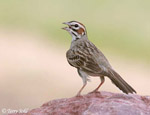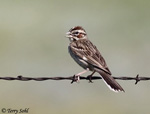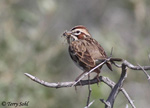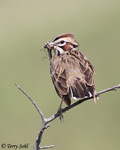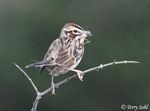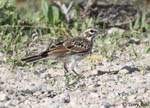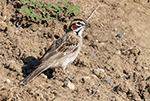Lark Sparrow
Chondestes grammacus
| Length: 6.5 inches | Wingspan: 11 inches | Seasonality: Summer |
| ID Keys: Distinctive face pattern with rusty ear patch, dark spot on chest, white edged tail | ||
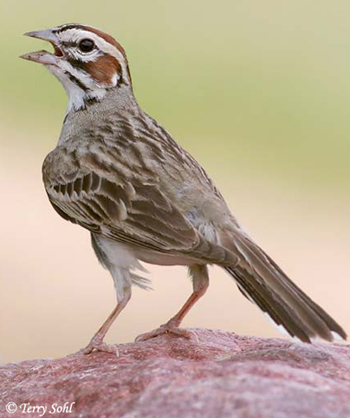 Lark Sparrows are
a unique sparrow species in multiple ways, particularly in appearance, where the
very strong and colorful facial pattern easily differentiates them from other
sparrow species. They also have a courtship behavior unlike most sparrows, with
the males approaching a female by hopping towards her along the ground, then
crouching on the ground, raising his tail and spreading it to show the white
tail edges, and spreading his wings, all in a posture somewhat similar to a bird
taking a dust bath.
Lark Sparrows are
a unique sparrow species in multiple ways, particularly in appearance, where the
very strong and colorful facial pattern easily differentiates them from other
sparrow species. They also have a courtship behavior unlike most sparrows, with
the males approaching a female by hopping towards her along the ground, then
crouching on the ground, raising his tail and spreading it to show the white
tail edges, and spreading his wings, all in a posture somewhat similar to a bird
taking a dust bath.
Lark Sparrows are very much a bird of the open habitats of the western US. When European settlers arrived on the continent and began clearing the great forests of the eastern US, the newly opened up habitat was suitable for Lark Sparrows, and the moved eastward, even reach the east coast of the US. In the last 100 years as forests have reclaimed open land in the eastern US, their populations have plummeted. Loss of grassland habitat in the Midwest and Great Plains has also had a toll on overall populations, but there are still many places in the central and western US where Lark Sparrows are relatively common.
Habitat:
Prefers open ground with scattered taller plants. Across their very broad range, that could include habitats as varied as grasslands with scattered bushes, hedgerows separating farm fields, juniper scrublands, sagebrush expanses, and other open and/or shrubby habitats.
Diet:
Lark Sparrows feed on both vegetative matter and animal matter, with the diet primarily consisting of insects in the summer months (particularly during breeding when protein is required for raising young). In the winter months the diet consists mostly of seeds.
Behavior:
Lark Sparrows are gregarious in most seasons outside of early in the breeding season, foraging along the ground in small flocks. When courting, males can be extremely defensive, with males often meeting and doing a mid-air dance as they grapple and try to chase each other from a territory. Lark Sparrows spend most of the their time on or near the ground, foraging along the ground or very low in grasslands or shrubby vegetation.
Nesting:
May through July in South Dakota. The nest of a Lark Sparrow is a sturdy cup, constructed of twigs, grasses, and weed stems, and lined with finer grasses, rootlets, animal hair, or feathers. The female lays between 3 and 6 eggs, and she alone incubates them. The young hatch after about 12 nest, and fledge from the nest in another 10-12 days or so after hatching.
Song:
The song of a Lark Sparrow is a jumbled mix of trills, buzzy notes, and musical phrases. The typical call is a short tink, but they will sometimes make a variety of short call notes that seem to consist of the same "vocabulary" that comprises the long, complex, and jumbled songs.
1Click here to hear the song of a Lark Sparrow
2Click here to hear a variety of different calls (all from the same bird)
Migration:
Summers in much of the central and western United States and into south-central Canada. Winters in the extreme southern U.S. and points south. Populations in the extreme southern U.S. and California are often permanent residents.
Interactive eBird Map:
Click here to access an interactive eBird map of Lark Sparrow sightings
Similar Species:
If seen well, Lark Sparrows are unlikely to be confused with another species. The very strong facial pattern, particularly with the rich reddish brown cheek patch and crown, are quite unlike any other sparrow species.
Bird Feeders:
Will occasionally attend feeders for some seeds and grains.
Conservation Status:
Lark Sparrows have declined substantially in overall populations in the last several decades. The losses have been significantly strong in the eastern part of their range, but numbers in the early half of the 20th century may have been artificially high in the Eastern US as forest clearing in the 19th and early 20th centuries created substantial new open habitat for them than was there historically. With regrowth of forest lands in the East, some of that habitat has now decreased. It's not just the east where habitat change has resulted in Lark Sparrow declines, however, as conversion of grassland to cropland in the Midwest and Great Plains has also had a big impact on overall populations. However, despite the strong population declines, Lark Sparrows are still found across a broad geographic area and are common in parts of that range. For those reasons, the IUCN still considers the Lark Sparrow to be a species of "Least Concern".
Further Information:
2) Audubon Guide - Lark Sparrow
Photo Information:
July 3rd, 2005 -- Perry Nature Area east of Sioux Falls -- Terry Sohl
Additional Photos:
Click on the image chips or text links below for additional, higher-resolution Lark Sparrow photos.
Audio File Credits:
1Paul Marvin. Recorded in San Diego County, California on March 25th, 2020. Original recording and information from xeno-canto.
2Andrew Spencer. Recorded in Moffat County, Colorado on May 12th, 2012. Original recording and information from xeno-canto.
| Click on the map below for a higher-resolution view |
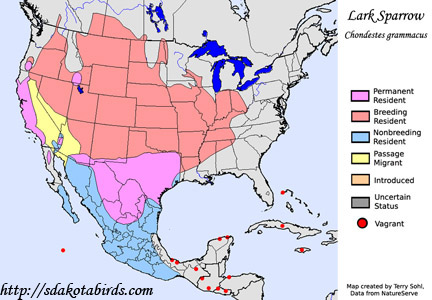 |
| South Dakota Status: Common summer resident in the western part of the state, uncommon in the southeast. Rare elsewhere. |
Additional Lark Sparrow Photos
Click for a higher-resolution version of these photos
